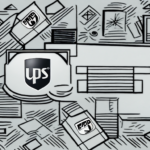How to Set Up Shipping Rates with UPS
If you're an e-commerce business owner seeking a reliable carrier for your shipments, UPS (United Parcel Service) might be the perfect option for you. Renowned for its efficient and timely delivery services, UPS is a top choice among online retailers. Before you start using UPS for your shipments, it's crucial to understand how to set up shipping rates with them. This comprehensive guide will walk you through the process, step-by-step, ensuring you optimize your shipping strategy for both cost and efficiency.
Why Choose UPS as Your Shipping Carrier
UPS has established itself as a dependable and trustworthy shipping carrier among both individuals and businesses. With a global reach spanning over 220 countries and territories, UPS integrates seamlessly with popular e-commerce platforms, making it the ideal choice for online retailers.
- Wide Range of Services: UPS offers various shipping options, including ground, air, and international shipping, catering to diverse business needs.
- Advanced Tracking: Their package tracking and delivery notifications ensure that both you and your customers stay informed about shipment statuses in real-time.
- Reliability: With a delivery success rate of over 99.5%, UPS ensures that packages arrive on time and in excellent condition.
In addition to reliable shipping services, UPS prioritizes sustainability and environmental responsibility. They have implemented initiatives to reduce their carbon footprint, such as using alternative fuel vehicles and investing in renewable energy sources. According to UPS's 2023 sustainability report, they aim to achieve carbon neutrality by 2050. By choosing UPS as your shipping carrier, you support a company committed to a greener future.
Understanding UPS Shipping Rates
UPS shipping rates vary based on several factors, including the shipping destination, package weight and dimensions, and the selected shipping service. Generally, the more weight and distance a package has to travel, the higher the shipping rate.
Another factor influencing UPS shipping rates is the type of package being shipped. Packages containing hazardous materials or requiring special handling may incur higher rates. Additionally, seasonal demand, particularly during the holiday season, can impact rates due to increased shipment volumes.
Factors That Affect UPS Shipping Rates
Several elements influence UPS shipping rates:
- Package Weight and Dimensions: Heavier and larger packages cost more to ship.
- Shipping Destination: Rates vary based on whether the destination is local, regional, or international.
- Service Type: Options like Ground, Next Day Air, or Second Day Air affect the overall cost.
- Package Value: High-value packages may require additional insurance, increasing shipping costs.
- Special Handling: Items classified as hazardous materials or oversized items may incur extra fees.
- Seasonal Demand: Peak seasons can lead to higher rates due to increased demand.
Additionally, UPS offers various discounts and promotions throughout the year based on shipping volume, package weight, and shipping frequency. Exploring these discounts can lead to significant savings on your shipping costs.
How to Calculate Shipping Costs with UPS
UPS provides a shipping calculator tool on their website, allowing you to estimate shipping costs based on your package's weight, dimensions, and destination. Simply enter the required information, and the tool will provide an estimated shipping cost.
However, it's important to note that the estimated cost is just that—an estimate. The actual shipping cost may vary based on additional factors such as selected service types, surcharges, and the actual weight and dimensions of the package. Always double-check the final cost before finalizing your shipment to prevent any unexpected charges.
Different Types of UPS Shipping Services Available
UPS offers a variety of shipping services tailored to meet different business needs:
- UPS Ground: A cost-effective option for domestic shipments within the United States, typically delivering within 1-5 business days based on distance.
- UPS Next Day Air: Provides next-day delivery for urgent shipments, ideal for time-sensitive packages.
- Next Day Air Saver: Offers next-day delivery by the end of the day with cost savings compared to standard Next Day Air.
- UPS International Shipping: Enables shipping to over 220 countries and territories, with various options for delivery timelines and customs clearance.
Understanding the differences between these services allows you to choose the most appropriate option for your business needs, balancing cost and delivery speed effectively.
Creating a UPS Account for Shipping
The first step in setting up shipping rates with UPS is to create an account with them. Visit the UPS website and click on the "Sign Up or Log In" button in the top right corner. Follow the instructions to create a new account, ensuring you have all necessary information handy, such as your business name, address, and tax ID number.
Once your account is set up, you can manage your shipping preferences, track packages, and access various UPS tools and resources through the UPS website or mobile app.
Setting Up Your UPS Shipping Preferences
After creating your UPS account, it's essential to configure your shipping preferences to streamline your shipping process:
- Default Shipping Service: Select your preferred shipping service to simplify future shipments.
- Package Dimensions and Weights: Input standard package sizes and weights to expedite the shipping process.
- Delivery Notifications: Enable notifications to keep your customers informed about their shipment status.
- Package Tracking: Activate tracking features to monitor shipments in real-time.
Utilizing these settings ensures consistency and efficiency in your shipping operations, reducing the need to re-enter information for each shipment.
How to Create Shipping Labels with UPS
Creating shipping labels with UPS is straightforward once your shipping preferences are set. Follow these steps:
- Log into your UPS account.
- Select the shipment's origin and destination.
- Enter the package details, including weight and dimensions.
- Choose the desired shipping service.
- Review the shipping cost and print the label.
UPS also integrates with popular e-commerce platforms like Shopify, WooCommerce, and Magento, allowing for seamless label creation directly from your online store. This integration saves time and reduces the potential for errors in the shipping process.
Scheduling a Pickup with UPS
After creating your shipping label, the next step is to schedule a pickup. You can do this directly from your UPS account by selecting the pickup location, date, and time that works best for you.
UPS offers various pickup options to accommodate different shipping frequencies:
- One-Time Pickup: Ideal for occasional shipments.
- Recurring Pickup: Suitable for businesses with regular shipping needs.
- Smart Pickup: Automatically schedules pickups based on your shipping volume, reducing the need for manual scheduling.
Ensure someone is available to hand over the package to the UPS driver during the scheduled pickup window to avoid any delays.
Tracking Your UPS Shipments
UPS provides a robust tracking system that allows you to monitor the progress of your shipments in real-time. You can track your package's location, delivery status, and any relevant updates directly from your UPS account or by using the tracking number on your shipping label.
Additional tracking features include:
- Delivery Notifications: Receive email or text alerts for shipment updates.
- In-Transit Tracking: Monitor your package’s journey from origin to destination.
- Proof of Delivery: Access detailed delivery information, including recipient signatures.
These features ensure transparency and allow you to keep your customers informed, enhancing their overall experience.
Managing Returns with UPS
Handling returns efficiently is crucial for customer satisfaction. UPS offers solutions to streamline the returns process:
- Prepaid Return Labels: Include prepaid return labels with your shipments, making it easy for customers to return items.
- Scheduled Returns: Arrange for pickup of return packages directly from your location.
- Tracking Returns: Monitor the status of return shipments to manage inventory and customer refunds effectively.
By simplifying the returns process, you can enhance customer trust and encourage repeat business.
Tips for Saving Money on Shipping Costs with UPS
Shipping costs can significantly impact your bottom line. Here are strategies to minimize expenses when using UPS:
- Volume-Based Discounts: UPS offers discounts based on your shipping volume. The more you ship, the more you save.
- Optimize Packaging: Use appropriately sized packaging to reduce weight and dimensional fees.
- Consolidate Shipments: Combine multiple orders into a single shipment to take advantage of bulk shipping rates.
- Select Cost-Effective Services: Choose the most economical shipping service that meets your delivery timelines.
- Leverage UPS Tools: Utilize UPS’s billing options, such as automated billing, to track and manage shipping expenses effectively.
Negotiating rates directly with UPS, especially if you have a high shipping volume, can also lead to significant savings.
Common Mistakes to Avoid When Setting Up Shipping Rates with UPS
Avoiding common pitfalls can help you optimize your shipping strategy and reduce costs:
- Underestimating Package Weight or Dimensions: Ensure accurate measurements to prevent additional charges.
- Selecting the Wrong Shipping Service: Choose a service that aligns with your delivery requirements without incurring unnecessary costs.
- Providing Inaccurate Shipping Information: Double-check addresses and package details to avoid delays and additional fees.
- Ignoring Insurance Needs: For high-value items, ensure you have adequate insurance to protect against loss or damage.
- Failing to Utilize Discounts: Take advantage of available discounts and promotions to minimize shipping expenses.
By being mindful of these common mistakes, you can enhance the efficiency and cost-effectiveness of your shipping operations.
Setting up shipping rates with UPS is a detailed process that requires careful consideration of several factors. However, once your account and preferences are configured, you can streamline your shipping process, ensuring efficient and timely delivery of your packages. Follow the steps outlined in this guide, and you'll be well on your way to mastering UPS shipping for your business!






















